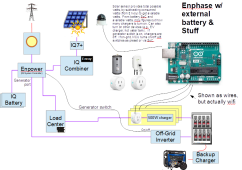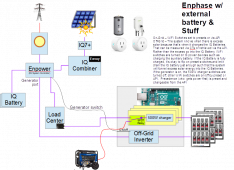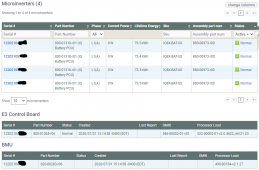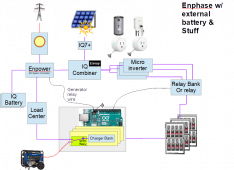Stuff in
italics is cut/paste from the manual....
When does it activate the generator input port,
IQ System Controller takes care of turning on and controlling auto-start generators when the utility grid is down, without any intervention from homeowners. The generator reduces dependency on environment variables (irradiance for solar power production) and provides an additional power source while the system is off grid. The generator can be used to supply power to loads and/or charge batteries.
Eco-friendly: The generator is started and stopped automatically based on battery State of Charge (SOC).
and does it then sync to it
Enphase’s generator support solution is “Generator AND PV + storage,” meaning generator and renewables (PV and IQ Battery) can operate at the same time providing backup power for the homeowners seamlessly.
and do generator support functions?
The Enphase Installer App provides an user configurable Generator Exercise Mode option. For example, the generator runs for 15 mins occasionally to keep its engine in good operating condition, as required by the manufacturer.
The “Quiet Time” feature provides the user a way to select a period during which the generator stays off unless battery SOC drops below a critical charge threshold.
In the diagram in the OP I lose out on the support functions, possibly someone will have some ideas about that. For some, it might make more sense to feed the generator directly into the generator port via a manual transfer switch to swap between it and the off-grid inverter. Wouldn't need the backup charger that way.
I hope it knows not to ever back feed into a generator.
The IQ Gateway in the system measures the generator, the PV, and the battery storage outputs to avoid back feeding power from PV or storage systems to the generator
Which sounds great, but I suspect some of the "minimum" sizing is to make sure there's enough metal to absorb surges when the high amp devices shut off (e.g., AC going off).
I have the generator input to my XW connected to a port for my 5,000 watt gasoline generator. It knows to not back feed when on the AC2 generator input, but my Enphase inverters would not know about it, so I have to manually turn off the solar breaker before I use the generator input. That should be on an interlocked transfer switch.
In a normal system (not the above configuration) the inverter generator goes through the NFT, so pretty nice really.
In the system above, the generator is just to charge the auxiliary batteries.
... is it worth having that battery bank just sitting there? ...
Really great question!
Currently, I'm light on both kW & kWh when the sun isn't shining so have to hunker down using a small subset and careful management based on the day's solar input. Ideally, the extra battery would let me capture excess sunshine to reuse at night.
No natural gas here, so I have to truck fuel for the generator...not always possible when the roads are out (last big storm we had boats and trees blocking the highway afterwards ;-). We're lucky in that it only takes days for stuff to happen as engineers need to inspect bridges before work crews are allowed to use them. Not knocking them, those guys are truly amazing and heroes in my book. But, a lot of that happens as fast as it does as power & gas companies are incentivized (e.g., we're not buying their product), as those companies weaken I expect more and longer disruptions.
The other problem is the generator needs to be an inverter generator to feed into the Enpower, and the one I have isn't. The configuration above let's me use what I have.
Long term I need to get rid of the generator though. Currently, when I store fuel for it, at the end of the season I put the fuel into the car lest the fuel go bad. When I swap out the last gas vehicle for an EV, I won't have anything to do with the excess gas.
Thanks for taking the time to go through it, always appreciate another pair of eyes.
What is your goal for doing this? Is it to add more run time when the grid is down?
Both energy (kWh) and power (kW). When the sun's not shining I've only a skimpy ~5 kW of inverter.
How is it going to compare to adding another Encharge-10 on cost and capability? A pair of the 5.1 KWH server rack batteries and something like a 6,000 watt Sigineer inverter charger could do the job.
Haven't compared costs yet, wanted to get the "alternative" down first so I could compare apples to apples.
Let's see, an IQ battery 10 is currently around $8k, has 10 kWh energy and 3.8kW inverter power.
The big costs in the system above appear to be the inverter and battery. At 30¢ Per Wh a 10 kWh battery is $3000. An 8kW Inverter (next size up on the minimum sizing for my current system) is about $4000, so $8k with all the other stuff?
Seems like a wash.... But, the more storage you want the cheaper it gets. For example, to add on an additional 10kWh would only be around +$3000. So $11k vs. $16k, or $14k vs $24k for 30 kWh. I'm certain battery prices will drop, but the kicker is if I'm going to DIY I should do it before Florida adopts NEC 2020.







